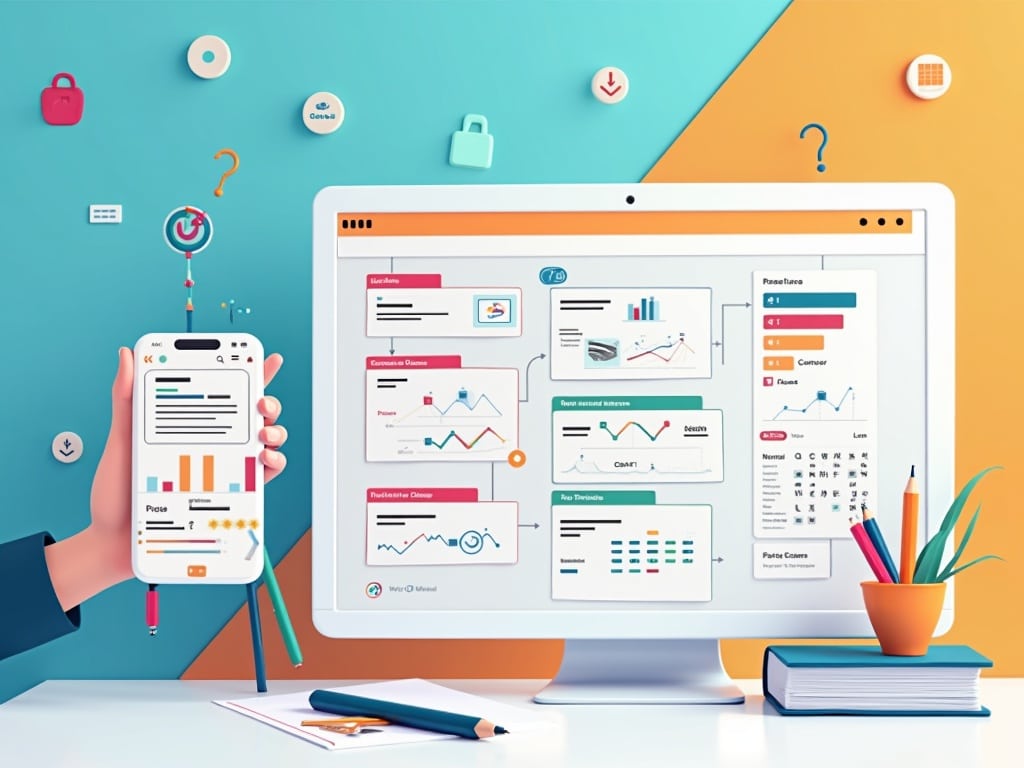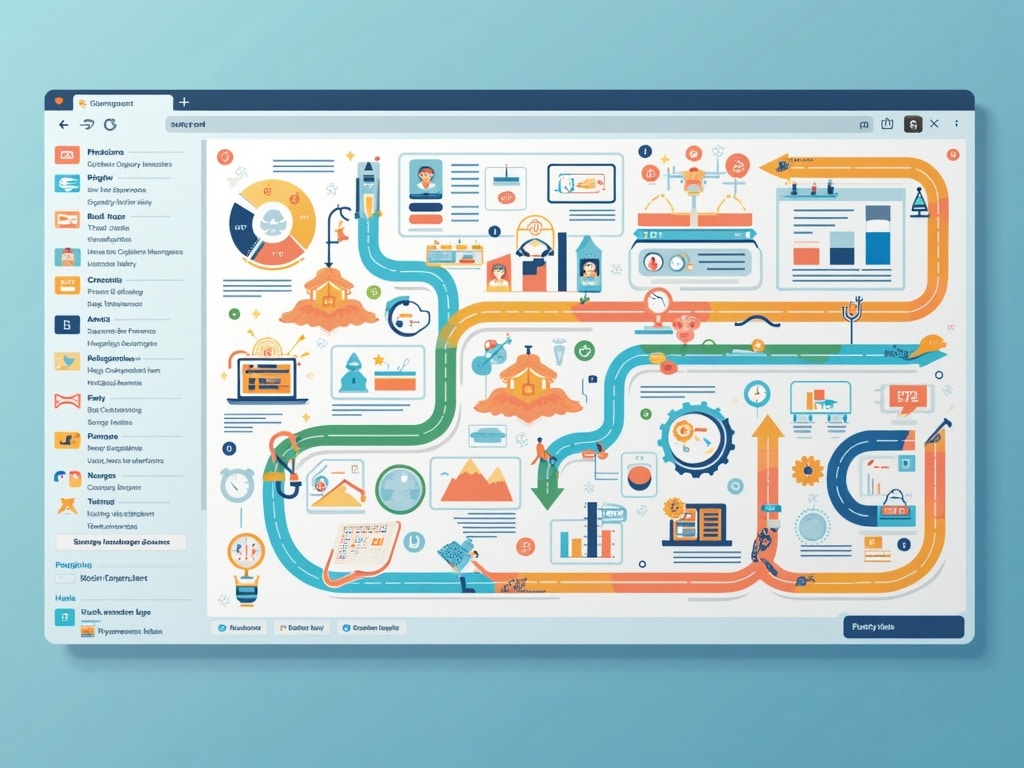Building a Simple Product Roadmap: A Practical Guide
Imagine trying to navigate a new city without a map. Chaotic, right? That’s precisely how developing a product without a roadmap feels. A product roadmap is your strategic visual guide, outlining the vision, direction, priorities, and progress of a product over time. It's not just a project plan; it's a dynamic document that aligns stakeholders, guides development, and charts the course for product success. But creating one doesn't have to be daunting. This guide will walk you through building a simple, effective product roadmap that keeps your team on track and your product vision clear.
Why Build a Product Roadmap? (The Benefits)
Before diving into the how, let's understand the why. Why invest time and effort in crafting a product roadmap? The benefits are plentiful:
- Alignment: A roadmap ensures everyone – from developers to marketing to sales – understands the product's direction and their role in achieving it.
- Prioritization: It helps you focus on the most valuable features, avoiding scope creep and wasted resources.
- Communication: It provides a clear and concise way to communicate the product strategy to stakeholders, fostering transparency and managing expectations.
- Strategic Decision-Making: By visualizing the product's evolution, you can make more informed decisions about resource allocation, feature development, and market positioning.
- Adaptability: A good roadmap isn't set in stone. It allows you to adapt to changing market conditions, customer feedback, and new opportunities.
Step 1: Define Your Product Vision and Goals
Every great product starts with a clear vision. What problem are you solving? Who are you solving it for? What makes your solution unique? Your product vision acts as the North Star, guiding all subsequent decisions.
**Craft a Concise Vision Statement:Distill your product's purpose into a single, memorable sentence. For example: To empower small businesses with affordable and intuitive marketing tools.
**Identify Key Goals:Define measurable objectives that align with your vision. These could be related to user acquisition, market share, revenue, or customer satisfaction. Use the SMART framework: Specific, Measurable, Achievable, Relevant, and Time-bound. An example goal: Increase user sign-ups by 20% in the next quarter.
**Know Your Audience: Thoroughly understand your target users – their needs, pain points, and motivations. This informs feature prioritization and ensures you are building a product people actually want. Conduct user research, analyze market trends, and gather feedback to develop robust user personas.
Step 2: Gather Ideas and Feedback
A product roadmap shouldn't be created in a vacuum. Solicit input from various sources to ensure you're building the right things.
**Customer Feedback: This is gold. Collect feedback through surveys, interviews, user testing, and support tickets. Pay close attention to recurring themes and pain points.
**Team Input: Engage your development, marketing, sales, and support teams. They often have valuable insights into technical feasibility, market opportunities, and customer needs.
**Market Research:Stay informed about industry trends, competitor activities, and emerging technologies. This helps you identify potential opportunities and avoid pitfalls.
**Brainstorming Sessions: Organize brainstorming sessions to generate new ideas and explore potential features. Encourage open communication and a no idea is a bad idea atmosphere.
Step 3: Prioritize Features and Initiatives
Now that you have a pool of ideas, it's time to prioritize them. Not all features are created equal, and some will have a greater impact on your product's success than others. Several prioritization frameworks can help:
**Impact/Effort Matrix: Plot each feature on a matrix with Impact on one axis and Effort on the other. Focus on features with high impact and low effort first (quick wins). Then, tackle high-impact, high-effort features strategically. Low-impact features can often be deprioritized or eliminated.
**MoSCoW Method: Categorize features into Must have, Should have, Could have, and Won't have. This provides a clear framework for deciding what to include in your roadmap and what to defer.
**Kano Model:This model categorizes features based on how they impact customer satisfaction:
*Must-be Quality*: Basic features that customers expect. If these are missing, customers will be dissatisfied.
*One-Dimensional Quality*: Features that directly increase customer satisfaction as they are implemented better.
*Attractive Quality*: Unexpected features that delight customers.
*Indifferent Quality*: Features that have no impact on customer satisfaction.
*Reverse Quality*: Features that decrease customer satisfaction.
**Weighted Scoring: Assign scores to each feature based on criteria like business value, customer impact, technical feasibility, and strategic alignment. Calculate a total score for each feature to determine its priority.
Step 4: Choose a Roadmap Format and Tool
The format of your roadmap depends on your needs and the audience you're presenting to. Here are a few common options:
**Timeline View:A chronological representation of features and initiatives, showing when they are planned for release. This is useful for communicating progress and managing expectations.
**Theme-Based Roadmap: Organizes features around strategic themes or goals. This highlights the why behind the roadmap and helps align stakeholders around a common vision.
**Kanban Board:A visual workflow management tool that allows you to track the progress of features through different stages of development (e.g., To Do, In Progress, Done).
There are also numerous tools available to help you create and manage your product roadmap:
**Dedicated Roadmap Software: Examples include Productboard, Aha!, and Roadmunk. These tools offer advanced features for prioritization, collaboration, and visualization.
**Project Management Tools: Tools like Jira, Asana, and Trello can be used to create basic roadmaps, especially for teams already using them for project management.
**Spreadsheets: While less visually appealing, spreadsheets can be a simple and effective way to create a basic roadmap, especially for smaller teams.
**Presentation Software: PowerPoint or Keynote can be used to create visually appealing roadmaps for presentations to stakeholders.

Step 5: Create Your Roadmap
With your vision, goals, prioritized features, and chosen format in hand, it's time to build your roadmap.
**Define Time Horizons:Break down your roadmap into manageable timeframes. Common horizons include:
*Now:Features currently being worked on.
*Next:Features planned for the immediate future (e.g., next quarter).
*Later:Features that are less defined and planned for the longer term.
Visualize Your Roadmap: Use your chosen format and tool to create a visual representation of your product strategy. Keep it clear, concise, and easy to understand.
Include Key Information: For each feature, include a brief description, its priority, the estimated timeframe for development, and the team responsible.
Use Color-Coding and Labels: Visual cues can help stakeholders quickly understand the roadmap. For example, use different colors to represent different themes or initiatives.
Step 6: Share and Communicate Your Roadmap
A roadmap is only effective if it is shared and communicated effectively.
**Present to Stakeholders: Present your roadmap to key stakeholders, including executives, product managers, developers, and marketing teams. Explain the rationale behind your decisions and solicit feedback.
**Make it Accessible: Store your roadmap in a central location where everyone can access it easily (e.g., a shared drive, a project management tool, or a dedicated roadmap platform).
**Regular Updates: Keep your roadmap up-to-date and communicate any changes to stakeholders promptly.
**Solicit Feedback Continuously:Encourage ongoing feedback on your roadmap to ensure it remains aligned with customer needs and business goals.
Step 7: Iterate and Adapt
A product roadmap is a living document, not a static plan. As your product evolves, the market changes, and you gather new information, you'll need to iterate on your roadmap.
**Regular Review Meetings:Schedule regular meetings to review your roadmap and make adjustments as needed.
**Track Progress and Metrics: Monitor key metrics to assess the success of your roadmap. Are you achieving your goals? Are you delivering value to customers?
Be Flexible and Adaptable:** Don't be afraid to change your roadmap if necessary. The most important thing is to stay focused on your product vision and goals.
**Embrace Change: The tech landscape is constantly evolving. Be prepared to adapt your roadmap to respond to new opportunities and challenges.
Common Pitfalls to Avoid
**Trying to predict too far into the future:Focus on the near term and keep longer-term plans flexible.
**Overcommitting to specific dates:Use ranges and estimations instead of firm deadlines, especially for long-term initiatives.
**Building a roadmap in isolation:Involve key stakeholders throughout the process.
**Creating a roadmap that is too detailed:Keep it high-level and focus on the what and why rather than the how.
**Ignoring customer feedback:Customer input is crucial for ensuring you're building the right product.
**Treating the roadmap as a rigid plan:Be prepared to adapt and iterate as needed.
Conclusion
Building a simple product roadmap doesn't have to be a complicated process. By following these steps, you can create a valuable tool that aligns your team, prioritizes your efforts, and guides your product towards success. Remember to keep your roadmap flexible, adaptable, and customer-focused. A well-crafted roadmap is an investment in your product's future, helping you navigate the ever-changing landscape and deliver a product that truly resonates with your audience. Now go forth, map your journey, and build something amazing!

